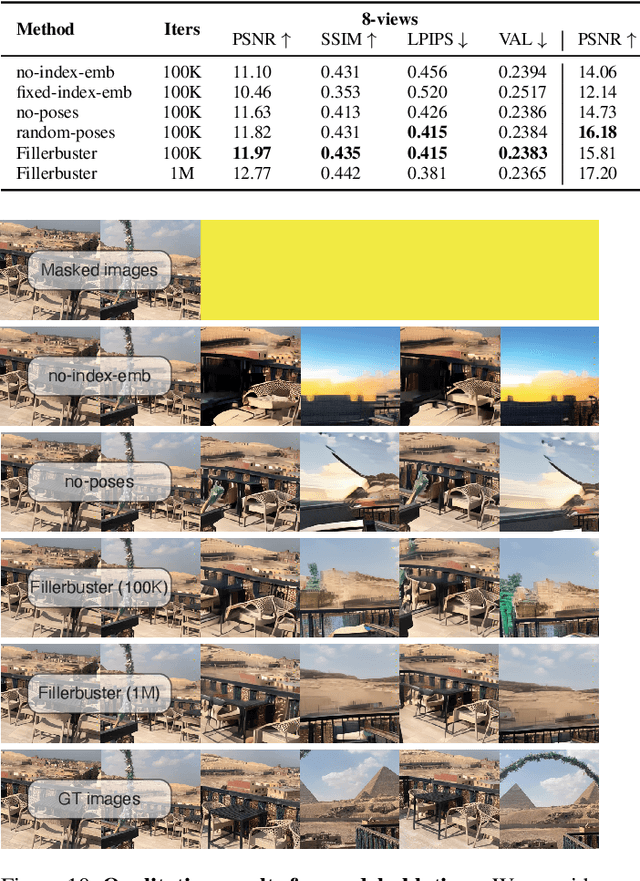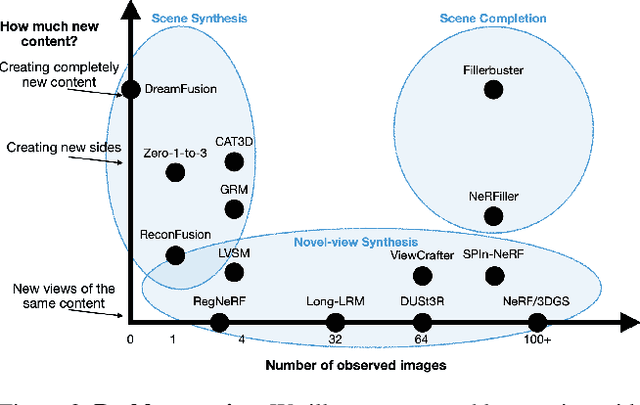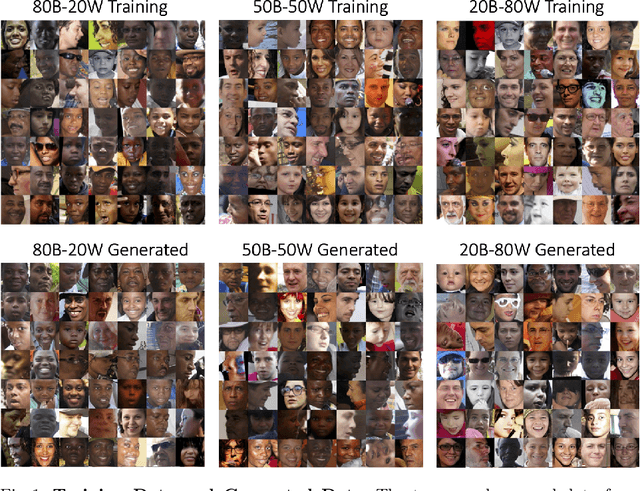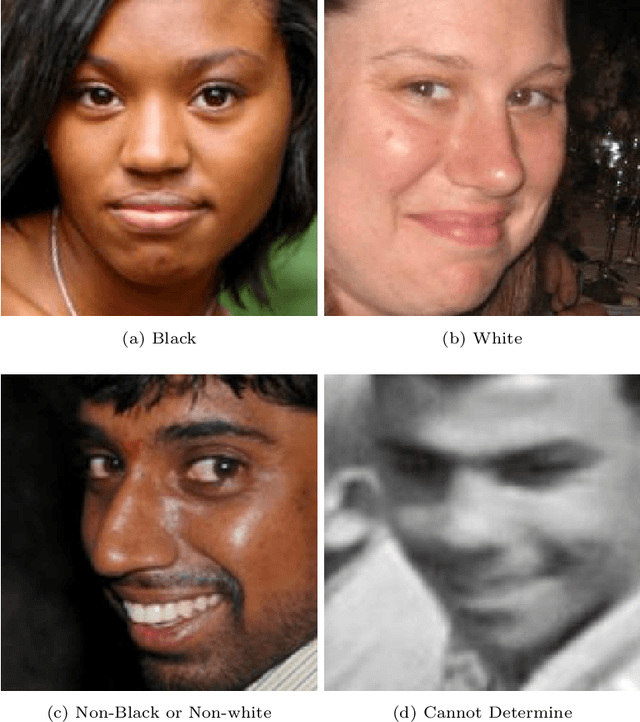Ethan Weber
Flow Matching Policy Gradients
Jul 28, 2025Abstract:Flow-based generative models, including diffusion models, excel at modeling continuous distributions in high-dimensional spaces. In this work, we introduce Flow Policy Optimization (FPO), a simple on-policy reinforcement learning algorithm that brings flow matching into the policy gradient framework. FPO casts policy optimization as maximizing an advantage-weighted ratio computed from the conditional flow matching loss, in a manner compatible with the popular PPO-clip framework. It sidesteps the need for exact likelihood computation while preserving the generative capabilities of flow-based models. Unlike prior approaches for diffusion-based reinforcement learning that bind training to a specific sampling method, FPO is agnostic to the choice of diffusion or flow integration at both training and inference time. We show that FPO can train diffusion-style policies from scratch in a variety of continuous control tasks. We find that flow-based models can capture multimodal action distributions and achieve higher performance than Gaussian policies, particularly in under-conditioned settings.
Eye, Robot: Learning to Look to Act with a BC-RL Perception-Action Loop
Jun 12, 2025Abstract:Humans do not passively observe the visual world -- we actively look in order to act. Motivated by this principle, we introduce EyeRobot, a robotic system with gaze behavior that emerges from the need to complete real-world tasks. We develop a mechanical eyeball that can freely rotate to observe its surroundings and train a gaze policy to control it using reinforcement learning. We accomplish this by first collecting teleoperated demonstrations paired with a 360 camera. This data is imported into a simulation environment that supports rendering arbitrary eyeball viewpoints, allowing episode rollouts of eye gaze on top of robot demonstrations. We then introduce a BC-RL loop to train the hand and eye jointly: the hand (BC) agent is trained from rendered eye observations, and the eye (RL) agent is rewarded when the hand produces correct action predictions. In this way, hand-eye coordination emerges as the eye looks towards regions which allow the hand to complete the task. EyeRobot implements a foveal-inspired policy architecture allowing high resolution with a small compute budget, which we find also leads to the emergence of more stable fixation as well as improved ability to track objects and ignore distractors. We evaluate EyeRobot on five panoramic workspace manipulation tasks requiring manipulation in an arc surrounding the robot arm. Our experiments suggest EyeRobot exhibits hand-eye coordination behaviors which effectively facilitate manipulation over large workspaces with a single camera. See project site for videos: https://www.eyerobot.net/
Pippo: High-Resolution Multi-View Humans from a Single Image
Feb 11, 2025Abstract:We present Pippo, a generative model capable of producing 1K resolution dense turnaround videos of a person from a single casually clicked photo. Pippo is a multi-view diffusion transformer and does not require any additional inputs - e.g., a fitted parametric model or camera parameters of the input image. We pre-train Pippo on 3B human images without captions, and conduct multi-view mid-training and post-training on studio captured humans. During mid-training, to quickly absorb the studio dataset, we denoise several (up to 48) views at low-resolution, and encode target cameras coarsely using a shallow MLP. During post-training, we denoise fewer views at high-resolution and use pixel-aligned controls (e.g., Spatial anchor and Plucker rays) to enable 3D consistent generations. At inference, we propose an attention biasing technique that allows Pippo to simultaneously generate greater than 5 times as many views as seen during training. Finally, we also introduce an improved metric to evaluate 3D consistency of multi-view generations, and show that Pippo outperforms existing works on multi-view human generation from a single image.
Fillerbuster: Multi-View Scene Completion for Casual Captures
Feb 07, 2025



Abstract:We present Fillerbuster, a method that completes unknown regions of a 3D scene by utilizing a novel large-scale multi-view latent diffusion transformer. Casual captures are often sparse and miss surrounding content behind objects or above the scene. Existing methods are not suitable for handling this challenge as they focus on making the known pixels look good with sparse-view priors, or on creating the missing sides of objects from just one or two photos. In reality, we often have hundreds of input frames and want to complete areas that are missing and unobserved from the input frames. Additionally, the images often do not have known camera parameters. Our solution is to train a generative model that can consume a large context of input frames while generating unknown target views and recovering image poses when desired. We show results where we complete partial captures on two existing datasets. We also present an uncalibrated scene completion task where our unified model predicts both poses and creates new content. Our model is the first to predict many images and poses together for scene completion.
Toon3D: Seeing Cartoons from a New Perspective
May 17, 2024Abstract:In this work, we recover the underlying 3D structure of non-geometrically consistent scenes. We focus our analysis on hand-drawn images from cartoons and anime. Many cartoons are created by artists without a 3D rendering engine, which means that any new image of a scene is hand-drawn. The hand-drawn images are usually faithful representations of the world, but only in a qualitative sense, since it is difficult for humans to draw multiple perspectives of an object or scene 3D consistently. Nevertheless, people can easily perceive 3D scenes from inconsistent inputs! In this work, we correct for 2D drawing inconsistencies to recover a plausible 3D structure such that the newly warped drawings are consistent with each other. Our pipeline consists of a user-friendly annotation tool, camera pose estimation, and image deformation to recover a dense structure. Our method warps images to obey a perspective camera model, enabling our aligned results to be plugged into novel-view synthesis reconstruction methods to experience cartoons from viewpoints never drawn before. Our project page is https://toon3d.studio .
NeRFiller: Completing Scenes via Generative 3D Inpainting
Dec 07, 2023Abstract:We propose NeRFiller, an approach that completes missing portions of a 3D capture via generative 3D inpainting using off-the-shelf 2D visual generative models. Often parts of a captured 3D scene or object are missing due to mesh reconstruction failures or a lack of observations (e.g., contact regions, such as the bottom of objects, or hard-to-reach areas). We approach this challenging 3D inpainting problem by leveraging a 2D inpainting diffusion model. We identify a surprising behavior of these models, where they generate more 3D consistent inpaints when images form a 2$\times$2 grid, and show how to generalize this behavior to more than four images. We then present an iterative framework to distill these inpainted regions into a single consistent 3D scene. In contrast to related works, we focus on completing scenes rather than deleting foreground objects, and our approach does not require tight 2D object masks or text. We compare our approach to relevant baselines adapted to our setting on a variety of scenes, where NeRFiller creates the most 3D consistent and plausible scene completions. Our project page is at https://ethanweber.me/nerfiller.
Nerfbusters: Removing Ghostly Artifacts from Casually Captured NeRFs
Apr 21, 2023Abstract:Casually captured Neural Radiance Fields (NeRFs) suffer from artifacts such as floaters or flawed geometry when rendered outside the camera trajectory. Existing evaluation protocols often do not capture these effects, since they usually only assess image quality at every 8th frame of the training capture. To push forward progress in novel-view synthesis, we propose a new dataset and evaluation procedure, where two camera trajectories are recorded of the scene: one used for training, and the other for evaluation. In this more challenging in-the-wild setting, we find that existing hand-crafted regularizers do not remove floaters nor improve scene geometry. Thus, we propose a 3D diffusion-based method that leverages local 3D priors and a novel density-based score distillation sampling loss to discourage artifacts during NeRF optimization. We show that this data-driven prior removes floaters and improves scene geometry for casual captures.
Nerfstudio: A Modular Framework for Neural Radiance Field Development
Feb 08, 2023



Abstract:Neural Radiance Fields (NeRF) are a rapidly growing area of research with wide-ranging applications in computer vision, graphics, robotics, and more. In order to streamline the development and deployment of NeRF research, we propose a modular PyTorch framework, Nerfstudio. Our framework includes plug-and-play components for implementing NeRF-based methods, which make it easy for researchers and practitioners to incorporate NeRF into their projects. Additionally, the modular design enables support for extensive real-time visualization tools, streamlined pipelines for importing captured in-the-wild data, and tools for exporting to video, point cloud and mesh representations. The modularity of Nerfstudio enables the development of Nerfacto, our method that combines components from recent papers to achieve a balance between speed and quality, while also remaining flexible to future modifications. To promote community-driven development, all associated code and data are made publicly available with open-source licensing at https://nerf.studio.
Studying Bias in GANs through the Lens of Race
Sep 15, 2022



Abstract:In this work, we study how the performance and evaluation of generative image models are impacted by the racial composition of their training datasets. By examining and controlling the racial distributions in various training datasets, we are able to observe the impacts of different training distributions on generated image quality and the racial distributions of the generated images. Our results show that the racial compositions of generated images successfully preserve that of the training data. However, we observe that truncation, a technique used to generate higher quality images during inference, exacerbates racial imbalances in the data. Lastly, when examining the relationship between image quality and race, we find that the highest perceived visual quality images of a given race come from a distribution where that race is well-represented, and that annotators consistently prefer generated images of white people over those of Black people.
The One Where They Reconstructed 3D Humans and Environments in TV Shows
Jul 28, 2022



Abstract:TV shows depict a wide variety of human behaviors and have been studied extensively for their potential to be a rich source of data for many applications. However, the majority of the existing work focuses on 2D recognition tasks. In this paper, we make the observation that there is a certain persistence in TV shows, i.e., repetition of the environments and the humans, which makes possible the 3D reconstruction of this content. Building on this insight, we propose an automatic approach that operates on an entire season of a TV show and aggregates information in 3D; we build a 3D model of the environment, compute camera information, static 3D scene structure and body scale information. Then, we demonstrate how this information acts as rich 3D context that can guide and improve the recovery of 3D human pose and position in these environments. Moreover, we show that reasoning about humans and their environment in 3D enables a broad range of downstream applications: re-identification, gaze estimation, cinematography and image editing. We apply our approach on environments from seven iconic TV shows and perform an extensive evaluation of the proposed system.
 Add to Chrome
Add to Chrome Add to Firefox
Add to Firefox Add to Edge
Add to Edge